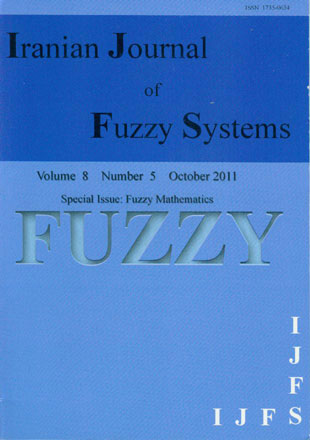فهرست مطالب

Iranian journal of fuzzy systems
Volume:8 Issue: 5, Oct 2011
- Special Issue: Fuzzy Mathatics
- تاریخ انتشار: 1390/09/17
- تعداد عناوین: 11
-
-
Page 1The starting point of this paper is given by Priestley’s papers, where a theory of representation of distributive lattices is presented. The purpose of this paper is to develop a representation theory of fuzzy distributive lattices in the finite case. In this way, some results of Priestley’s papers are extended. In the main theorem, we show that the category of finite fuzzy Priestley spaces is equivalent to the dual of the category of finite fuzzy distributive lattices. Several examples are also presented.
-
Page 13Motivated by the recent study on categorical properties of latticevalued topology, the paper considers a generalization of the notion of topological system introduced by S. Vickers, providing an algebraic and a coalgebraic category of the new structures. As a result, the nature of the category TopSys of S. Vickers gets clari ed, and a metatheorem is stated, claiming that (latticevalued) topology can be embedded into algebra.
-
Page 31In this paper, let $L$ be a complete residuated lattice, and let {\bf Set} denote the category of sets and mappings, $LF$-{\bf Pos} denote the category of $LF$-posets and $LF$-monotone mappings, and $LF$-{\bf CSLat}$(\sqcup)$, $LF$-{\bf CSLat}$(\sqcap)$ denote the category of $LF$-complete lattices and $LF$-join-preserving mappings and the category of $LF$-complete lattices and $LF$-meet-preserving mappings, respectively. It is proved that there are adjunctions between {\bf Set} and $LF$-{\bf CSLat}$(\sqcup)$, between $LF$-{\bf Pos} and $LF$-{\bf CSLat}$(\sqcup)$, and between $LF$-{\bf Pos} and $LF$-{\bf CSLat}$(\sqcap)$, that is, {\bf Set}$\dashv LF$-{\bf CSLat}$(\sqcup)$, $LF$-{\bf Pos}$\dashv LF$-{\bf CSLat}$(\sqcup)$, and $LF$-{\bf Pos}$\dashv$ $LF$-{\bf CSLat}$(\sqcap)$. And a usual mapping $f$ generates the traditional Zadeh forward powerset operator $f_L^\rightarrow$ and the fuzzy forward powerset operators $\widetilde{f}^\rightarrow, \widetilde{f}_\ast^\rightarrow, \widetilde{f}^{\ast\rightarrow}$ defined by the author et al via these adjunctions. Moreover, it is also shown that all the fuzzy powerset operators mentioned above can be generated by the underlying algebraic theories.
-
Page 59In this paper, our focus of attention is the proper propagation of fuzzy degrees in determinization of $Nondeterministic$ $Fuzzy$ $Finite$ $Tree$ $Automata$ (NFFTA). Initially, two determinization methods are introduced which have some limitations (one in behavior preserving and other in type of fuzzy operations). In order to eliminate these limitations and increasing the efficiency of FFTA, we define the notion of fuzzy complex state and $Complex$ $FFTA$ (CFFTA). Also, we define $\nabla$-normalization operation in algebra of fuzzy complex state to solve the multi membership state problem in fuzzy automata. Furthermore, we discuss the relationship between FFTA and CFFTA. Finally, determinization of CFFTA is presented.
-
Page 69This paper, deals with some equivalence relations in fuzzy subgroups. Further the probability of commuting two fuzzy subgroups of some finite abelian groups is defined.
-
Page 81By means of a kind of new idea, we consider the $(\in,\ivq)$-fuzzy $h$-ideals of a hemiring. First, the concepts of $(\in,\ivq)$-fuzzy left(right) $h$-ideals of a hemiring are provided and some related properties are investigated. Then, a kind of quotient hemiring of a hemiring by an $(\in,\ivq)$-fuzzy $h$-ideal is presented and studied. Moreover, the notions of generalized $\varphi$-compatible $(\in,\ivq)$-fuzzy left(right) $h$-ideals of a hemiring are introduced and some properties of them are provided. Finally, the relationships among $(\in,\ivq)$-fuzzy $h$-ideals, quotient hemirings and homomorphisms are explored and several homomorphism theorems are provided.
-
Page 103Abstract. An idea of fuzzy re exivity of Felbin''s type fuzzy normed linear spaces is introduced and its properties are studied. Concept of fuzzy uniform normal structure is given and using the geometric properties of this concept xed point theorems are proved in fuzzy normed linear spaces.
-
Page 117In this note, we aim to present some properties of the space of all weakly fuzzy bounded linear operators, with the Bag and Samanta’s operator norm on Felbin’s-type fuzzy normed spaces. In particular, the completeness of this space is studied. By some counterexamples, it is shown that the inverse mapping theorem and the Banach-Steinhaus’s theorem, are not valid for this fuzzy setting. Also finite dimensional normed fuzzy spaces are considered briefly. Next, a Hahn-Banach theorem for weakly fuzzy bounded linear functional with some of its applications are established.
-
Page 131In this paper, the gradual real numbers are considered and the notion of the gradual normed linear space is given. Also some topological properties of such spaces are studied, and it is shown that the gradual normed linear space is a locally convex space, in classical sense. So the results in locally convex spaces can be translated in gradual normed linear spaces. Finally, we give an example of a gradual normed linear space which is not normable in classical analysis.
-
Page 141In this paper, the notion of $\psi -$ weak contraction [18] is extended to fuzzy metric spaces. The existence of common xed points for two mappings is established where one mapping is $\psi -$ weak contraction with respect to another mapping on a fuzzy metric space. Our result generalizes a result of Gregori and Sapena [9].
-
Page 149In this paper we investigate the algebraic properties of dimension of fuzzy hypervector spaces. Also, we prove that two isomorphic fuzzy hypervector spaces have the same dimension.

